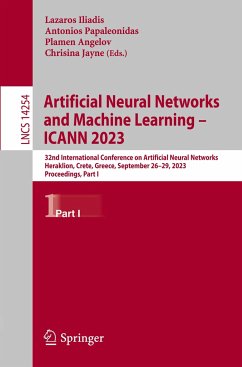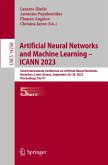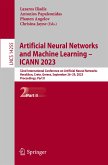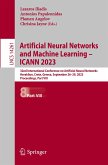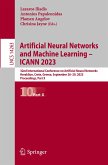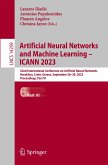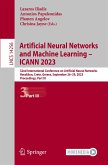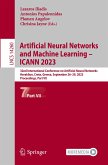Artificial Neural Networks and Machine Learning - ICANN 2023
32nd International Conference on Artificial Neural Networks, Heraklion, Crete, Greece, September 26-29, 2023, Proceedings, Part I
Herausgegeben:Iliadis, Lazaros; Papaleonidas, Antonios; Angelov, Plamen; Jayne, Chrisina
Artificial Neural Networks and Machine Learning - ICANN 2023
32nd International Conference on Artificial Neural Networks, Heraklion, Crete, Greece, September 26-29, 2023, Proceedings, Part I
Herausgegeben:Iliadis, Lazaros; Papaleonidas, Antonios; Angelov, Plamen; Jayne, Chrisina
- Broschiertes Buch
- Merkliste
- Auf die Merkliste
- Bewerten Bewerten
- Teilen
- Produkt teilen
- Produkterinnerung
- Produkterinnerung
The 10-volume set LNCS 14254-14263 constitutes the proceedings of the 32nd International Conference on Artificial Neural Networks and Machine Learning, ICANN 2023, which took place in Heraklion, Crete, Greece, during September 26-29, 2023.
The 426 full papers, 9 short papers and 9 abstract papers included in these proceedings were carefully reviewed and selected from 947 submissions. ICANN is a dual-track conference, featuring tracks in brain inspired computing on the one hand, and machine learning on the other, with strong cross-disciplinary interactions and applications.
Andere Kunden interessierten sich auch für
![Artificial Neural Networks and Machine Learning - ICANN 2023 Artificial Neural Networks and Machine Learning - ICANN 2023]() Artificial Neural Networks and Machine Learning - ICANN 202368,99 €
Artificial Neural Networks and Machine Learning - ICANN 202368,99 €![Artificial Neural Networks and Machine Learning - ICANN 2023 Artificial Neural Networks and Machine Learning - ICANN 2023]() Artificial Neural Networks and Machine Learning - ICANN 202362,99 €
Artificial Neural Networks and Machine Learning - ICANN 202362,99 €![Artificial Neural Networks and Machine Learning - ICANN 2023 Artificial Neural Networks and Machine Learning - ICANN 2023]() Artificial Neural Networks and Machine Learning - ICANN 202368,99 €
Artificial Neural Networks and Machine Learning - ICANN 202368,99 €![Artificial Neural Networks and Machine Learning - ICANN 2023 Artificial Neural Networks and Machine Learning - ICANN 2023]() Artificial Neural Networks and Machine Learning - ICANN 202368,99 €
Artificial Neural Networks and Machine Learning - ICANN 202368,99 €![Artificial Neural Networks and Machine Learning - ICANN 2023 Artificial Neural Networks and Machine Learning - ICANN 2023]() Artificial Neural Networks and Machine Learning - ICANN 202368,99 €
Artificial Neural Networks and Machine Learning - ICANN 202368,99 €![Artificial Neural Networks and Machine Learning - ICANN 2023 Artificial Neural Networks and Machine Learning - ICANN 2023]() Artificial Neural Networks and Machine Learning - ICANN 202368,99 €
Artificial Neural Networks and Machine Learning - ICANN 202368,99 €![Artificial Neural Networks and Machine Learning - ICANN 2023 Artificial Neural Networks and Machine Learning - ICANN 2023]() Artificial Neural Networks and Machine Learning - ICANN 202362,99 €
Artificial Neural Networks and Machine Learning - ICANN 202362,99 €-
-
-
The 10-volume set LNCS 14254-14263 constitutes the proceedings of the 32nd International Conference on Artificial Neural Networks and Machine Learning, ICANN 2023, which took place in Heraklion, Crete, Greece, during September 26-29, 2023.
The 426 full papers, 9 short papers and 9 abstract papers included in these proceedings were carefully reviewed and selected from 947 submissions. ICANN is a dual-track conference, featuring tracks in brain inspired computing on the one hand, and machine learning on the other, with strong cross-disciplinary interactions and applications.
The 426 full papers, 9 short papers and 9 abstract papers included in these proceedings were carefully reviewed and selected from 947 submissions. ICANN is a dual-track conference, featuring tracks in brain inspired computing on the one hand, and machine learning on the other, with strong cross-disciplinary interactions and applications.
Produktdetails
- Produktdetails
- Lecture Notes in Computer Science 14254
- Verlag: Springer / Springer Nature Switzerland / Springer, Berlin
- Artikelnr. des Verlages: 978-3-031-44206-3
- 1st ed. 2023
- Seitenzahl: 632
- Erscheinungstermin: 22. September 2023
- Englisch
- Abmessung: 235mm x 155mm x 34mm
- Gewicht: 943g
- ISBN-13: 9783031442063
- ISBN-10: 3031442067
- Artikelnr.: 68599079
- Herstellerkennzeichnung
- Springer-Verlag GmbH
- Tiergartenstr. 17
- 69121 Heidelberg
- ProductSafety@springernature.com
- Lecture Notes in Computer Science 14254
- Verlag: Springer / Springer Nature Switzerland / Springer, Berlin
- Artikelnr. des Verlages: 978-3-031-44206-3
- 1st ed. 2023
- Seitenzahl: 632
- Erscheinungstermin: 22. September 2023
- Englisch
- Abmessung: 235mm x 155mm x 34mm
- Gewicht: 943g
- ISBN-13: 9783031442063
- ISBN-10: 3031442067
- Artikelnr.: 68599079
- Herstellerkennzeichnung
- Springer-Verlag GmbH
- Tiergartenstr. 17
- 69121 Heidelberg
- ProductSafety@springernature.com
A classification performance evaluation measure considering data separability.- A Cross-Modal View to Utilize Label Semantics for Enhancing Student Network in Multi-Label Classification.- A Hybrid Model Based on Samples Difficulty for Imbalanced Data Classification.- A New Dataset for Hair Follicle Recognition and Classification in Robot-Aided Hair Transplantation.- A Policy for Early Sequence Classification.- A Study of Data-driven Methods for Adaptive Forecasting of COVID-19 Cases.- An Ensemble Scheme Based on the Optimization of TOPSIS and AdaBoost for In-class Teaching Quality Evaluation.- Architecturing Binarized Neural Networks for Traffic Sign Recognition.- Boosting Few-Shot Classification with Lie Group Contrastive Learning.- Context Enhancement Methodology for action recognition in still images.- Discrete Denoising Diffusion Approach to Integer Factorization.- Distinguishing the correctness of knowledge makes knowledge transfer better.- Diversified Contrastive Learning For Few-Shot Classification.- Enhancing Cross-lingual Few-shot Named Entity Recognition by Prompt-guiding.- FAIR: A Causal Framework for Accurately Inferring Judgments Reversals.- FeatEMD: Better Patch Sampling and Distance Metric for Few-Shot Image Classification.- FFTRL: A Sparse Online Kernel Classification Algorithm for Large Scale Data.- Fusing Hand and Body Skeletons for Human Action Recognition in Assembly.- Gaze Behavior Patterns for Early Drowsiness Detection.- GH-QFL: Enhancing Industrial Defect Detection through Hard Example Mining.- HaarStyle:Revision Style Transfer Based on Multiple Resolutions.- Semi-Supervised Learning Classifier for Misinformation Related to Earthquakes Prediction on Social Media.- SkinDistilViT: Lightweight Vision Transformer for Skin Lesion Classification.- Sparse Block DETR: Precise and Speedy End-to-End Detector for PCB Defect Detection.- SWP:A Sliding Window Prompt for Emotion Recognition in Conversation.- VDCNet: A Vulnerability Detection and Classification System in Cross-Project Scenarios.- CFNet: Point Cloud Upsampling via Cascaded Feedback Network.- DA-TSD: Double Attention Two-Stage 3D Object Detector from Point Clouds.- Enhanced Point Cloud Interpretation via Style Fusion and Contrastive Learning in Advanced 3D Data Analysis.- PoinLin-Net: Point Cloud Completion Network Based on Geometric Feature Extraction and Linformer Structure.- Accurate detection of spiking motifs in multi-unit raster plots.- Context-dependent computations in spiking neural networks with apical modulation.- QMTS: Fixed-point quantization for multiple-timescale spiking neural networks.- Self-Organizing Temporally Coded Representation Learning.- A System-Level Brain Model for Enactive Haptic Perception in a Humanoid Robot.- Clarifying the Half Full or Half Empty Question: Multimodal Container Classification.- CycleIK: Neuro-inspired Inverse Kinematics.- Robot at the mirror: learning to imitate via associating self-supervised models.- Approximation of Binary-Valued Functions by Networks of Finite VC Dimension.- Color-Dependent Prediction Stability of Popular CNN Image Classification Architectures.- Improving Neural Network Verification Efficiency through Perturbation Refinement.- Relative intrinsic dimensionality is intrinsic to learning.- The Boundaries of Verifiable Accuracy, Robustness, and Generalisation in Deep Learning.- Componentwise Adversarial Attacks.- Decorelated Weight Initialization by Backpropagation.- Exploring individuality in human EEG using reservoir computing.- Learning efficient backprojections across cortical hierarchies in real time.- Neural self-organization for muscle-driven robots.- Novel Synthetic Data Tool for Data-Driven Cardboard Box Localization.- Reinforcement Learningwith Memory based Automatic Chunking for Complex Skill Acquisition.- Retinotopy improves the categorisation and localisation of visual objects in CNNs.- Safe Reinforcement Learning in a Simulated Robotic Arm.
A classification performance evaluation measure considering data separability.- A Cross-Modal View to Utilize Label Semantics for Enhancing Student Network in Multi-Label Classification.- A Hybrid Model Based on Samples Difficulty for Imbalanced Data Classification.- A New Dataset for Hair Follicle Recognition and Classification in Robot-Aided Hair Transplantation.- A Policy for Early Sequence Classification.- A Study of Data-driven Methods for Adaptive Forecasting of COVID-19 Cases.- An Ensemble Scheme Based on the Optimization of TOPSIS and AdaBoost for In-class Teaching Quality Evaluation.- Architecturing Binarized Neural Networks for Traffic Sign Recognition.- Boosting Few-Shot Classification with Lie Group Contrastive Learning.- Context Enhancement Methodology for action recognition in still images.- Discrete Denoising Diffusion Approach to Integer Factorization.- Distinguishing the correctness of knowledge makes knowledge transfer better.- Diversified Contrastive Learning For Few-Shot Classification.- Enhancing Cross-lingual Few-shot Named Entity Recognition by Prompt-guiding.- FAIR: A Causal Framework for Accurately Inferring Judgments Reversals.- FeatEMD: Better Patch Sampling and Distance Metric for Few-Shot Image Classification.- FFTRL: A Sparse Online Kernel Classification Algorithm for Large Scale Data.- Fusing Hand and Body Skeletons for Human Action Recognition in Assembly.- Gaze Behavior Patterns for Early Drowsiness Detection.- GH-QFL: Enhancing Industrial Defect Detection through Hard Example Mining.- HaarStyle:Revision Style Transfer Based on Multiple Resolutions.- Semi-Supervised Learning Classifier for Misinformation Related to Earthquakes Prediction on Social Media.- SkinDistilViT: Lightweight Vision Transformer for Skin Lesion Classification.- Sparse Block DETR: Precise and Speedy End-to-End Detector for PCB Defect Detection.- SWP:A Sliding Window Prompt for Emotion Recognition in Conversation.- VDCNet: A Vulnerability Detection and Classification System in Cross-Project Scenarios.- CFNet: Point Cloud Upsampling via Cascaded Feedback Network.- DA-TSD: Double Attention Two-Stage 3D Object Detector from Point Clouds.- Enhanced Point Cloud Interpretation via Style Fusion and Contrastive Learning in Advanced 3D Data Analysis.- PoinLin-Net: Point Cloud Completion Network Based on Geometric Feature Extraction and Linformer Structure.- Accurate detection of spiking motifs in multi-unit raster plots.- Context-dependent computations in spiking neural networks with apical modulation.- QMTS: Fixed-point quantization for multiple-timescale spiking neural networks.- Self-Organizing Temporally Coded Representation Learning.- A System-Level Brain Model for Enactive Haptic Perception in a Humanoid Robot.- Clarifying the Half Full or Half Empty Question: Multimodal Container Classification.- CycleIK: Neuro-inspired Inverse Kinematics.- Robot at the mirror: learning to imitate via associating self-supervised models.- Approximation of Binary-Valued Functions by Networks of Finite VC Dimension.- Color-Dependent Prediction Stability of Popular CNN Image Classification Architectures.- Improving Neural Network Verification Efficiency through Perturbation Refinement.- Relative intrinsic dimensionality is intrinsic to learning.- The Boundaries of Verifiable Accuracy, Robustness, and Generalisation in Deep Learning.- Componentwise Adversarial Attacks.- Decorelated Weight Initialization by Backpropagation.- Exploring individuality in human EEG using reservoir computing.- Learning efficient backprojections across cortical hierarchies in real time.- Neural self-organization for muscle-driven robots.- Novel Synthetic Data Tool for Data-Driven Cardboard Box Localization.- Reinforcement Learningwith Memory based Automatic Chunking for Complex Skill Acquisition.- Retinotopy improves the categorisation and localisation of visual objects in CNNs.- Safe Reinforcement Learning in a Simulated Robotic Arm.

